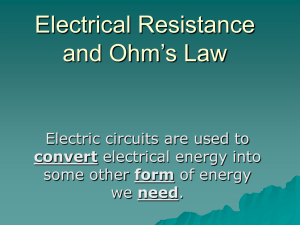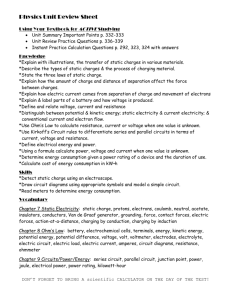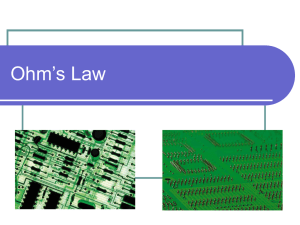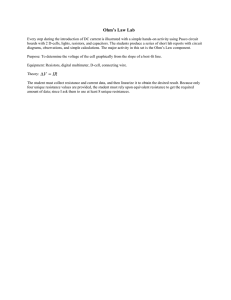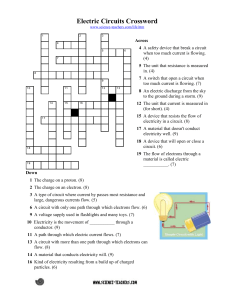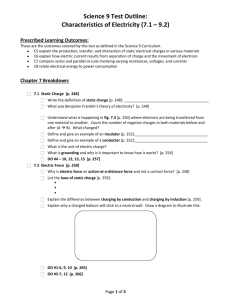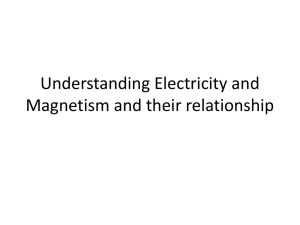Electricity - leavellphysicalscience
advertisement
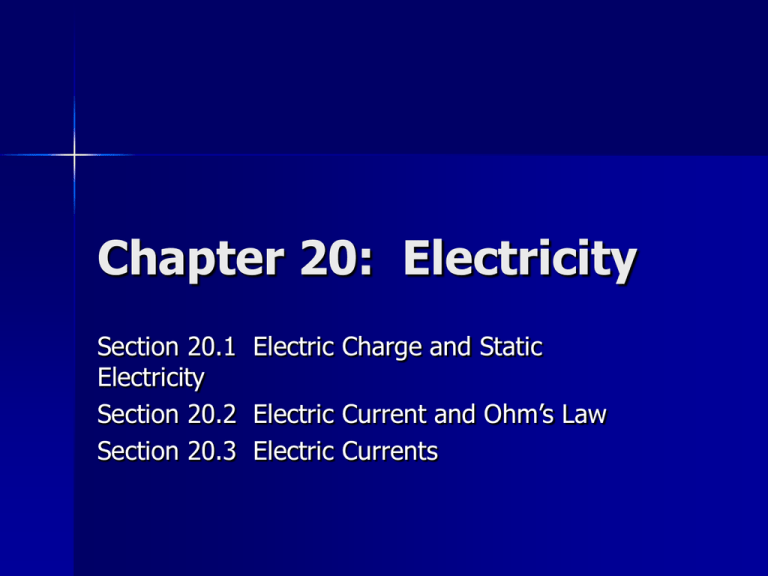
Chapter 20: Electricity Section 20.1 Electric Charge and Static Electricity Section 20.2 Electric Current and Ohm’s Law Section 20.3 Electric Currents Section 20.1 Electric Charge and Static Electricity Lightning and static cling result from the movement of electric charges. Electric Charge Def.-a property that causes subatomic particles such as protons and electrons to attract or repel each other Two types of electric charge: positive and negative Protons (+ charge) and electrons (- charge) Section 20.1 Electric Charge and Static Electricity Electric Charge Examples of movement: lightening bolts Examples of attraction: clothes taken out of the dryer Almost everything in our day to day lives is affected some way by charges. Section 20.1 Electric Charge and Static Electricity Electric Charge Cloud of (–) electrons surround (+) nucleus Atom is neutral b/c #protons=#electrons Atom gains 1 or more electrons becomes a negatively charged ion Atom loses electrons become a positively charged ion Key Concept: An excess or shortage or electrons produce a net electric charge. Section 20.1 Electric Charge and Static Electricity Electric Charges SI Unit of electric charge= C or coulomb Takes 6.24 x 1018 electrons to produce a single coulomb Section 20.1 Electric Charge and Static Electricity Electric Forces Key Concept: Like charges repel, and opposite charges attract. Electric force-the force of attraction or repulsion between electrically charged objects Charles-Augustin de Coulomb (1736-1806)discovered that electric forces obey laws similar to the law of universal gravitation Section 20.1 Electric Charge and Static Electricity Electric Forces Electric force b/t 2 objects directly proportional to net charge on each object and inversely proportional to the square of the distance between them. Doubling net charge on one object doubles the electric force Doubling distance between objects: electric force is one fourth as strong Electric forces inside atoms are much stronger than gravitational forces Section 20.1 Electric Charge and Static Electricity Electric Fields Def.-the effect an electric charge has on other charges in the space around it Key Concept: The strength of an electric field depends on the amount of charge that produces the field and on the distance from the charge. Figure 4 Section 20.1 Electric Charge and Static Electricity Electric Fields Exert forces on any charged object placed in the field Force depends on: net charge in the object, strength and direction of the field at the object’s position The greater the net charge an object has, the greater the force on it. Section 20.1 Electric Charge and Static Electricity Static Electricity and Charging Static electricity-the study of the behavior of electric charges, including how charge is transferred between objects Key Concept: Charge can be transferred by friction, by contact, and by induction. When charge transfer occurs, the total charge is the same before and after the transfer (law of conservation of charge) Section 20.1 Electric Charge and Static Electricity Charging by Friction Ex. Balloon attracts hair Electrons move from hair to balloon making balloon negative and hair becomes positive Ex. Walking across a carpet Section 20.1 Electric Charge and Static Electricity Charging by Contact Hair standing on end Person acquires a charge large enough where hairs have like charges Like charges repel Section 20.1 Electric Charge and Static Electricity Charging by Induction Ex. Walk across carpet and reach for doorknob You pick up electrons from the carpet: hand is negatively charged Net negative charge of hand repels the electrons in the metal doorknob Electrons move to base of doorknob=doorknob is positively charged in part Doorknob is still neutral but charge moved into it Induction-a transfer of charge without contact between materials Section 20.1 Electric Charge and Static Electricity Static Discharge Shock from doorknobs or other objects=result of static discharge Key Concept: Static discharge occurs when a pathway through which charges move forms suddenly. Air becomes charged suddenly when the gap b/t your finger and the doorknob is small. Air provide path for electrons to flow from your hand to the doorknob. Spark can be seen in the dark. Section 20.1 Electric Charge and Static Electricity Static Discharge Lightning-more dramatic discharge Friction between moving air masses causes charge to build up in storm clouds Negative charge in lower part of cloud induces a positive charge in the ground below it Amt. of charge in cloud ↑, attraction b/t charges in cloud and ground ↑ Air becomes charged (forms pathway for electrons to flow from cloud to the ground) Section 20.2 Electric Current and Ohm’s Law Electric Current Def.-the continuous flow of electric charge SI Unit of electric current-ampere (A); equals 1 coulomb/second Key Concept: The two types of current are direct current and alternating current. Direct current (DC)-charge flows in one direction Flashlight; most battery-operated devices Section 20.2 Electric Current and Ohm’s Law Electric Current Alternating current (AC)-a flow of electric charge that regularly reverses its direction Houses and schools A Flashlight Figure 8 Section 20.2 Electric Current and Ohm’s Law Conductors and Insulators Electrical conductor-a material through which charge can flow easily Electrical insulators-a material through which charge cannot flow easily Metals-have ions in a lattice that don’t move, but have some electrons that a not bound to the lattice =they can conduct charge **Most materials don’t conduct charge b/c they have no free electrons Metal such as copper and silver are good electrical conductors. Wood, plastics, rubber and air are good electrical insulators. Section 20. 2 Electrical current and Ohm’s Law Resistance Def.-opposition to the flow of charges in a material (SI unit=ohm) Key Concept: A material’s thickness, length, and temperature affect its resistance. Resistance > in long wire b/c charges have to travel farther; Temp. >=more resistance b/c electrons collide more often Section 20.2 Electric Current and Ohm’s Law Resistance Can resistance be 0? Superconductor-material that has almost zero resistance when it is cooled to low temperature. Section 20.2 Electric Current and Ohm’s Law Voltage Key Concept: In order for charge to flow in a conducting wire, the wire must be connected in a complete loop that includes a source of electrical energy. Potential Difference Objects at greater height have more potential than those at a lower height. So those objects fall from higher to a lower potential energy. This is true of charges. Charges flow spontaneously from a higher to lower potential energy. Section 20.2 Electric Current and Ohm’s Law Voltage (Potential Difference) Potential difference of a charge depends on its position in an electric field. Def.-the difference in electrical potential energy between two places in an electric field Measured in Joules/Coulombs (Volts) aka Voltage Voltage Sources Batteries, solar cells, and generators. Have terminals (positive and negative) that connect to wires in a circuit Battery-a device that converts chemical energy to electrical energy. Section 20.2 Electric Current and Ohm’s Law Ohm’s Law Ohm unit-German scientist-Georg Ohm (17891854) 1st determined how resistance and current affect voltage. Discovered voltage is not the same everywhere in a circuit; Hypothesized that resistance reduces voltage. Found a relationship b/t voltage, current, and resistance Section 20.2 Electric Current and Ohm’s Law Ohm’s Law Voltage (V) in a circuit equals the product of the current (I) and the resistance (R). V=I x R or I=V/R If current in amps and resistance in ohms, voltage in volts Key Concept: Increasing the voltage increases the current. Keeping the same voltage and increasing the resistance decreases the current. Section 20.3 Electric Currents Circuit Diagrams Electric current-a complete path through which charge can flow; wires in houses, etc. have complex networks of circuits Electricians use circuit diagrams to monitor how elements in a circuit are connected. Key Concept: Circuit diagrams use symbols to represent parts of a circuit, including a source of electrical energy and devices that run by the electrical energy Section 20.3 Electric Circuits Circuit Diagrams Show one or more complete paths where charge can flow Switches show where circuit can open; if open circuit not in a complete loop so current stops=open circuit If switch closed, the circuit is complete and charge can flow=closed circuit Section 20.3 Electric Circuits Electrons in a wire flow in the opposite direction. Series Circuits **Charge has only one path through which it can flow Key Concept: If one element stops functioning in a series circuit, none of the elements can operate. One light bulb blows it becomes an open circuit. Bulbs are a source of resistance; the more present the more resistance there is. >resistance=<current;decrease brightness of bulbs Section 20.3 Electric Currents Parallel Circuits Circuits in homes are mostly parallel. Def.-an electric circuit with two or more paths through which charges can flow Key Concept: If one element stops functioning in a parallel circuit, the rest of the elements still can operate. Allows independent operation of devices. Figure 12 Series and Parallel Circuits Section 20.3 Electric Circuits Power and Energy Calculations Electric power-the rate at which electrical energy is converted to another form of energy Units of joules per second (watt, W). Power measured in watts or kilowatts (kW) Key Concept: Electric power can be calculated by multiplying voltage by current. P (watts)=I (amps) x V (volts) **Appliances vary in the amount of power they use. Section 20.3 Section 20.3 Electric Currents Electrical Safety Inspectors check all new homes to make sure electrical wiring is installed safely. Key Concept: Correct wiring, fuses, circuit breakers, insulation, and grounded plugs help make electrical energy safe to use. The amount of current in a circuit depends on how many devices in the circuit. > # of devices turned on the > the current If current exceeds the circuits safety limit, wire may overheat and start a fire. Section 20.3 Electric Currents Home Safety Fuses prevent current overload in a circuit; wire in the center of a fuse melts if there is too much current passing through it “blowing a fuse”. Has to be replaced with a new one to use circuit Most homes use circuit breakers (a switch that opens when current in a circuit is too high); has to be reset for circuit to be used again Section 20.3 Electric Currents Personal Safety Electrical wiring is insulated to protect from shock Don’t touch electrical devices with wet hands Insulation prevents short circuits; three pronged plugs help prevent shocks from short circuits Circular prong connects to ground; current takes easier path to ground instead of entering your body Grounding-the transfer of excess charge through a conductor to Earth
